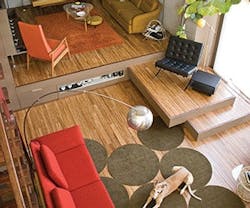Inside the Bamboo Biz
When it comes to making bamboo flooring, there’s a cheap way to do it, and then there’s the right way to do it. Unfortunately, the cheaply manufactured product often looks identical on the shelf, and it’s only after the flooring is installed that end-users will start to notice the difference in performance.
We sat down with David Keegan, COO of Bamboo Hardwoods, to learn the ins and outs of the manufacturing process, and identify those critical, invisible decisions manufacturers must make every step of the way to ensure bamboo flooring products will stand the test of time once they’re installed. Here’s what you need to know—and what you need to ask the manufacturer—to specify bamboo without getting bamboozled.
sourcing
Bamboo sourced at harvest maturity of 5 or 6 years is the densest and hardest, and maintains the health of the grove overall.
Bamboo sourced from the more temperate climate zones in China’s northern provinces are more dimensionally stable, with densely packed cells that won’t move as much after the manufacturing process (installed).
Bamboo sourced too young is not strong enough, and over-harvesting weakens the root system of the grove. Bamboo sourced too late begins to decay and get brittle, leading to weaker product performance.
Bamboo sourced from the tropical south shoots quicker, which leads to elongating cells that are less dimensionally stable.
drying
Adhesion
Bamboo is glued using specially-formulated adhesives designed for bamboo-to-bamboo bonds. These are most commonly specified from European manufacturers, where on-hand chemists provide technical support, full product warranties, and disclosures.
Roller machines apply adhesives at even levels—measured down to grams per square meter—to ensure the finished product performs consistently.
Bamboo is glued using generic adhesives from one of hundreds of pop-up domestic Chinese manufacturers.
Price is the only determining factor, and products come with no warranty, performance description, or disclosure of contents.
Adhesives applied in uneven quantities create inconsistencies in the finished product’s performance.
Pressing
Milling
Finished planks made with high-quality machinery are square and perpendicular, so all parts interlock perfectly, leaving a smooth and evenly finished flooring surface.
Finishing
Installation
